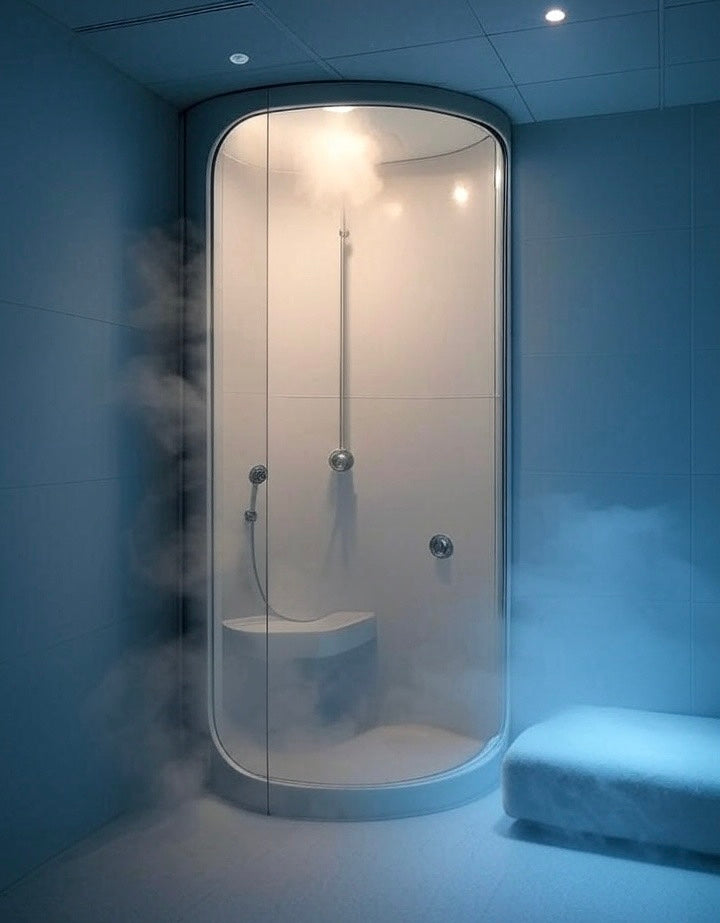Ever left a Steam Room feeling more woozy than refreshed? You're not alone. While a Steam bath feels like luxury, it can sneak in a few health risks too. Short answer: yes, a steam room can make you sick—but don’t sweat it just yet. Here's how to stay safe and steamy.

The Physical Risks and Side Effects of Using a Steam Room
Overheating, Dehydration, and Fainting
Spending too long in a steam room can push your body into overdrive. The high humidity makes it harder to cool down naturally, which raises your core temperature quite fast.
It may feel relaxing at first, but your body could be working overtime to regulate itself—especially if you’re not properly hydrated.
Recognising the Early Signs of Heat Exhaustion
Early signs of overheating include light-headedness, dizziness, nausea, and rapid breathing.
If you begin to feel shaky or disoriented, it’s time to leave the steam room straight away and rehydrate.
Why Dehydration Happens So Quickly
Steam rooms increase sweating, but since the air is already saturated, sweat doesn’t evaporate properly.
This fools your body into thinking it’s cooler than it actually is, encouraging more sweating and increasing the risk of dehydration without you realising it.
Recommended Time Limits for Steam Room Sessions
Most health experts advise limiting steam sessions to 15–20 minutes.
Any longer, and you’re entering dangerous territory—especially without adequate hydration before and after.
Cardiovascular Strain
How High Temperatures Affect Your Heart Rate
Heat causes your blood vessels to dilate, which in turn raises your heart rate as it tries to keep your body cool.
This natural response can feel like a slight racing of the heart, but for some, it might lead to discomfort or dizziness.
The Dangers for People with High or Low Blood Pressure
Those with existing heart conditions or blood pressure irregularities should take extra care.
Steam rooms may worsen symptoms, increase the risk of fainting, or cause unwanted pressure changes that put strain on your cardiovascular system.
Hygiene and Infection Risks in a Humid Environment
The Spread of Bacteria and Fungi
Steam rooms are warm, moist spaces where bacteria, fungi, and viruses can easily thrive.
Without proper cleaning and maintenance, the environment becomes ideal for germs to grow and spread.
Common Infections You Can Catch in a Steam Room
Athlete’s foot, fungal rashes, and warts are just a few of the common infections linked to steam rooms.
Bacteria and fungi survive longer in high-humidity areas and can be passed along on benches, floors, and even towels.
The Importance of Proper Hygiene and Footwear
To reduce risk, always wear flip-flops or rubber sandals, and sit on a clean towel.
Avoid using shared items and never go barefoot in communal areas.
Respiratory and Allergic Reactions
When a Steam Room Can Worsen Asthma or Allergies
While steam may help clear mild congestion, it can also aggravate conditions like asthma or allergies.
The dense, humid air might make breathing more difficult for those with sensitive lungs or pre-existing respiratory issues.
The Risk of Irritants and Contaminants
Steam rooms can contain irritants like cleaning product residues, mould, or perfumes left behind by other users.
These substances become airborne in the heat, which may trigger allergic reactions, coughing, or itchy eyes.
Who Should Avoid the Steam Room? (And What to Do)
Key Medical Contraindications
Individuals with Heart Conditions or Blood Pressure Issues
If you have a history of heart disease or irregular blood pressure, check with your doctor before using a steam room.
The heat and humidity may place strain on your circulatory system and raise the risk of complications.
The Risks for Pregnant Women and Children
Pregnant women and young children should avoid steam baths entirely.
Overheating can pose serious risks to developing foetuses and small bodies struggle to regulate heat as effectively as adults.
Avoiding Use When Sick or on Certain Medications
Steam rooms can worsen symptoms when you’re unwell.
And if you’re taking medication that affects hydration or heart rate, such as diuretics or beta-blockers, it’s safer to skip the steam.
Essential Precautions for Safe Use
The Importance of Hydration Before and After
Drink water before entering and rehydrate straight after your session.
Avoid alcohol or caffeine beforehand—they accelerate dehydration and increase risk.
The Critical Need to Consult a Doctor First
If you have any doubts about whether the steam room is suitable for you, speak with your GP.
It’s a quick check that could save you from unnecessary health complications.
Conclusion

Steam rooms can be wonderfully soothing, but they aren’t without risk. From overheating and dehydration to unexpected infections, it's best to steam with care.
Stay hydrated, keep sessions short, and practise good hygiene to enjoy the benefits safely.
Takeaways
-
Yes, steam rooms can make you sick—if you don’t follow precautions.
-
Watch out for overheating, dehydration, and hygiene issues.
-
Not suitable for everyone—especially if pregnant, sick, or with heart problems.
-
Stay hydrated and consult a doctor if unsure.
Would you like me to prep a matching Pinterest or Instagram caption, or suggest internal links for related blogs?






